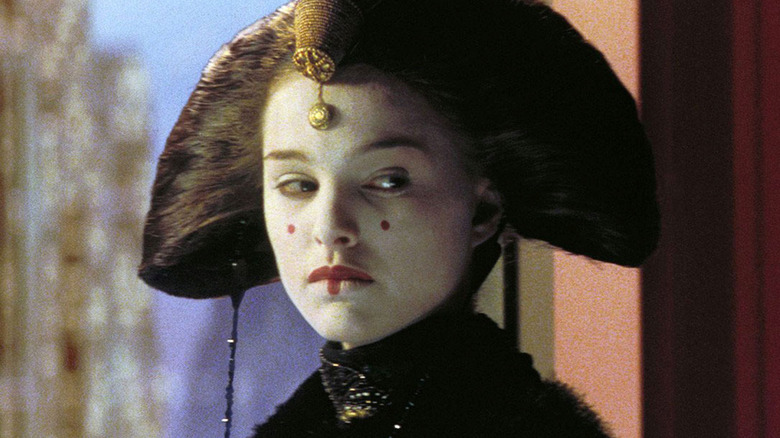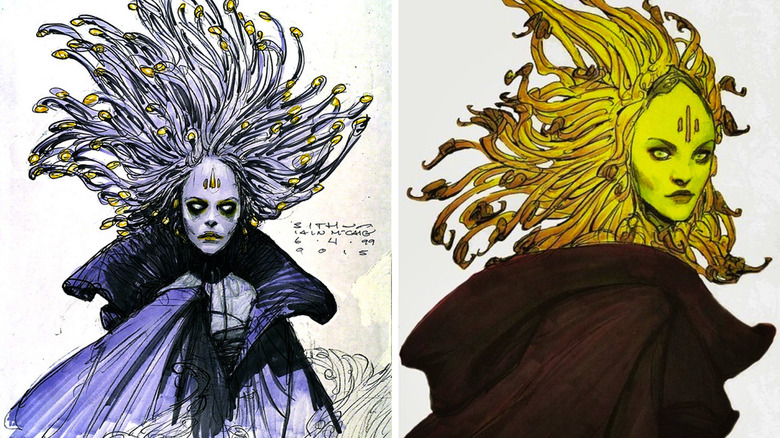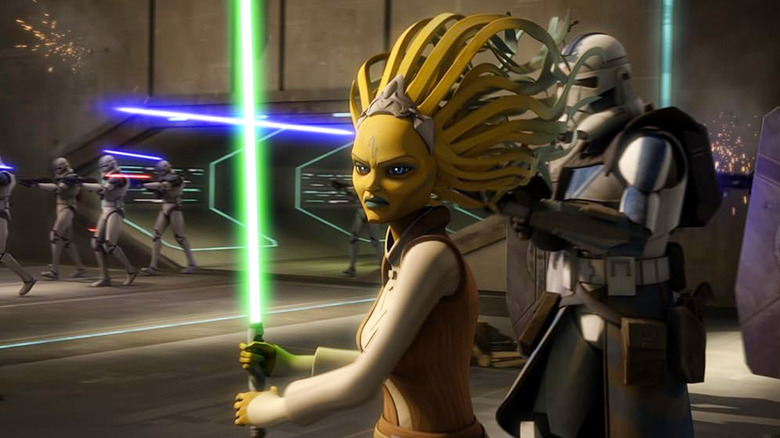Star Wars: Attack Of The Clones Almost Included A Villainous Padme
It's fair to say that Padmé Amidala is one of the "Star Wars" saga's most underappreciated characters. She played something of a thankless role throughout the prequel trilogy; while she's probably known best as Anakin Skywalker's romantic foil, she was so much more in the grand scheme.
Much ink has been spilled on Padmé's importance to the Galactic Republic, especially in "Episode II — Attack of the Clones." It's her fierce independence and general aversion to authority that made her such a threat to then-chancellor Palpatine. Most of his dastardly plans include efforts to remove Padmé entirely from the equation, either through the invasion of Naboo in "The Phantom Menace," or through a handful of assassination attempts.
Fortunately, Padmé managed to stick around longer than anyone expected her to. Her presence was a welcome challenge to the tyranny of the fledgling Empire, but also to the prequels' overwhelmingly male ensemble. She's one of the few female characters with any prominent role in the prequels, though not for lack of trying on the part of concept artist Iain McCaig. Had he gotten his way, Padmé wouldn't have been the only woman with significant power or influence in the prequels: she nearly shared the spotlight with a female Sith apprentice, a "Dark Queen" that would have been her mirror image.
Something for the girls
The demise of Darth Maul, while brief, left a power vacuum for the Sith. "Attack of the Clones," of course, would eventually fill that void with a new apprentice — and McCaig hoped to do so with a formidable female character. His process was recorded in R.A. Salvatore's "The Art of Star Wars: Attack of the Clones," which includes some of McCaig's concept art for a character he referred to as the "Dark Queen."
"I felt this was a great opportunity to introduce a strong woman character, to give girl fans an icon," McCaig told CBR at the time. "The challenge was finding a new archetype that would stand up there with Darth Vader and Darth Maul."
With the help of fellow concept artist Dermot Power, McCaig leaned into archetypes that had yet to be introduced in "Star Wars." His "Dark Queen" concept featured a lithe, green-skinned warrior with Medusa-like head tendrils. It's easy to see the parallels between this character and Padmé, who sported many a headdress in her tenure as queen and senator. The duo also drafted concepts for a vampire-like witch and even a shape-shifting femme fatale.
The Dark Queen likely would have served as a direct liaison to Darth Sidious, filling the role that Count Dooku later did in "Attack of the Clones." It's not likely that her path would've crossed with Padmé's, but it'd have been nice to see a female warrior play a big role in the film's more intrigue-heavy sequences.
Consolation prizes
Unfortunately, the idea of a female villain was short-lived. "Star Wars" creator George Lucas eventually proposed the idea of a disillusioned Jedi Master, and efforts pivoted to developing Count Dooku as the main antagonist in "Attack of the Clones."
While McCaig's Dark Queen never truly came to life, his designs were later repurposed for minor characters in "Star Wars: The Clone Wars." They informed the creation of a species called the Mikkians, two of whom were introduced in the season 6 episode "The Unknown." "The Clone Wars" also circled back to Power's witchy Sith warrior, using his designs for fan favorite villain Asajj Ventress. Their shape-shifting alien, meanwhile, influenced the final look for bounty hunter Zam Wesell.
Though the majority of these characters played relatively small roles in the saga, it's nice to know that Lucasfilm doesn't let its best ideas go to total waste. Female representation has since improved, however marginally, in live-action: "The Rise of Skywalker" even teased the idea of a female Sith with Dark Rey. The dearth of representation in the prequels is still disappointing, even 20-plus years later — but the future is still bright for the franchise, especially with so many female-led stories on the horizon.


